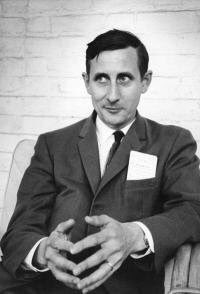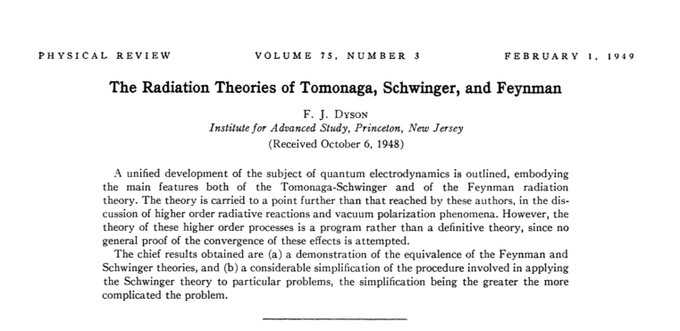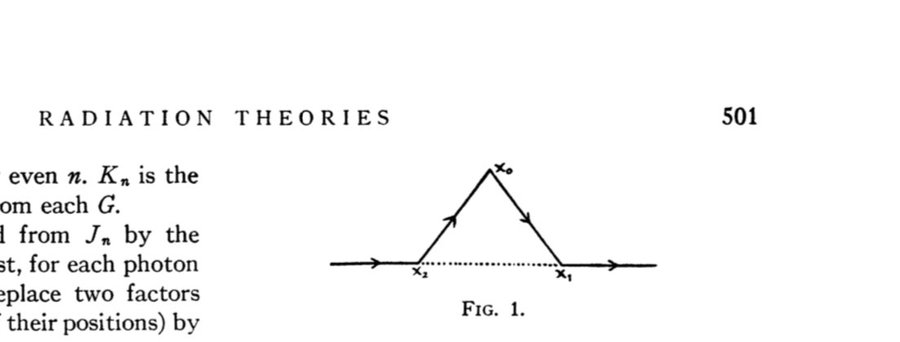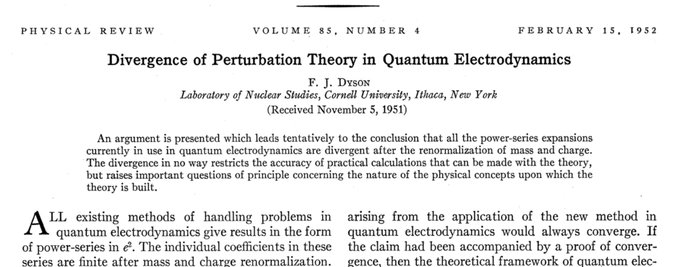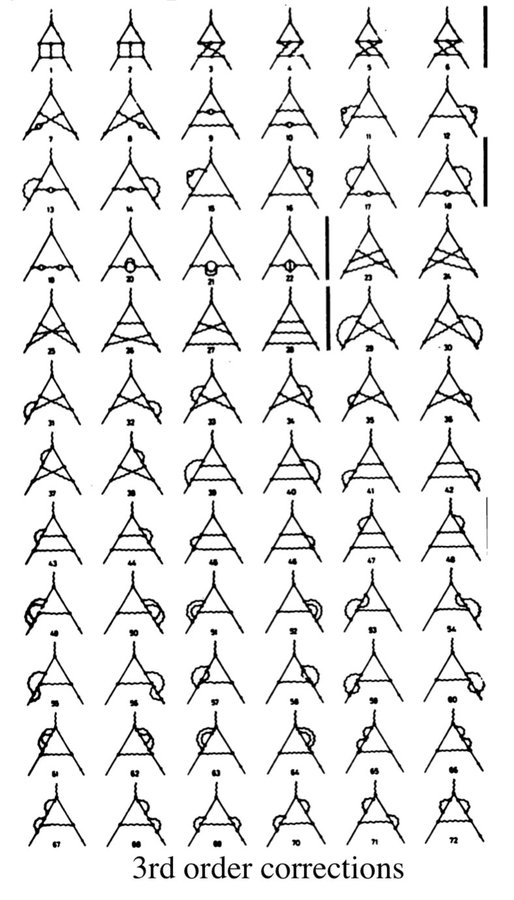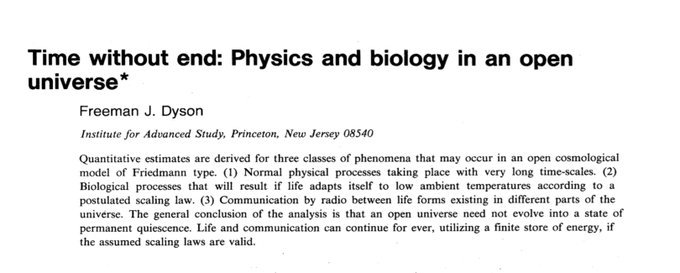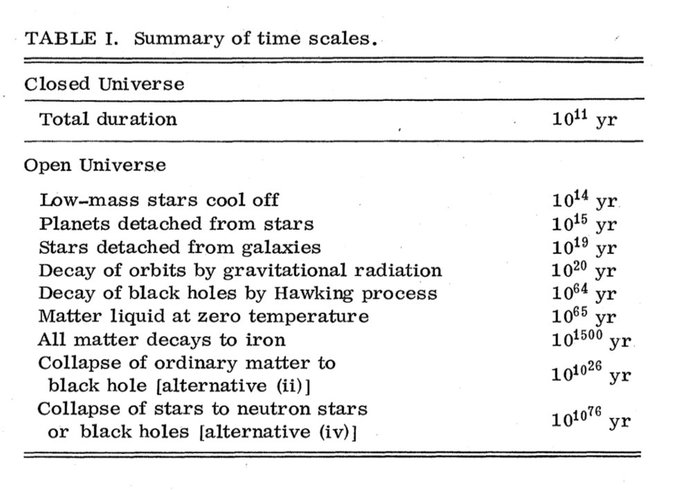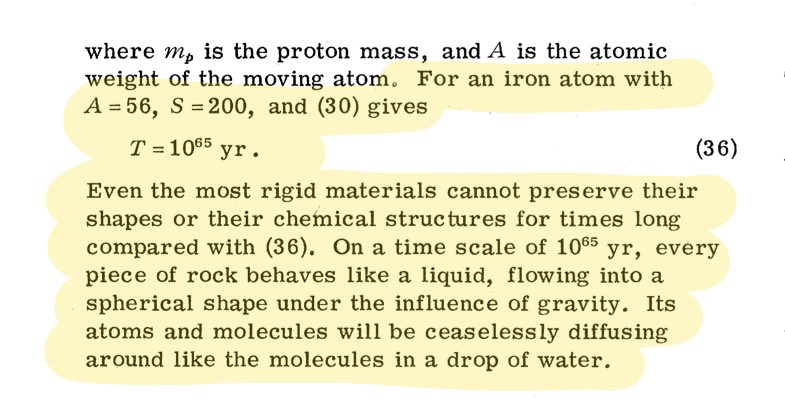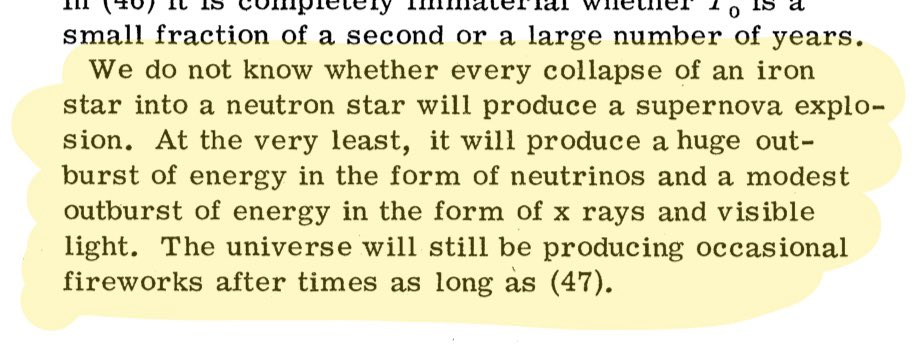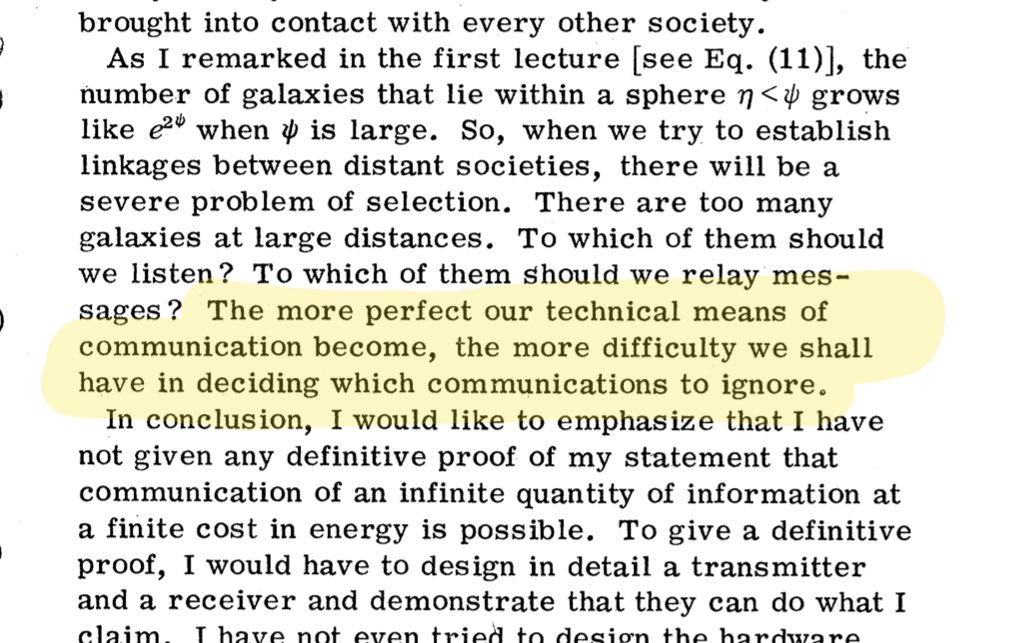Physicist Freeman Dyson was born #OTD in 1923. He was known for his work in quantum electrodynamics and –– among many other things –– his eschatological musings about physics and the prospects for life in the far-flung future.
Photo: Heka Davis / AIP
Photo: Heka Davis / AIP
Dyson passed away in February of this year, at the age of 96. He was to the best of my knowledge the most prominent physicist of the modern era who never completed a PhD.
Before I begin, let me note that Dyson took an unfortunate position on climate change, allowing that humans have an impact but insisting that existing models are too unreliable. He was wrong. Maybe it was a contrary streak, or maybe he was just wrong. I'll let others comment.
Dyson was one of the first physicists to really understand the meaning and power of Feynman's diagrammatic approach to QED. He published a paper in 1949 showing that this method was equivalent to the operator approach of Schwinger & Tomonaga.
Ref: Dyson, Phys. Rev. 75, 486–502
Ref: Dyson, Phys. Rev. 75, 486–502
It turns out, the Japanese physicists Koba and Takeda had submitted similar work just two days before.
When Dyson learned of this he amended his paper to recognize their work. He lamented the effect of the war on the dissemination of important ideas: "The isolation of these Japanese workers has undoubtedly constituted a serious loss to theoretical physics."
But probably my favorite bit of field theory work by Dyson is a beautiful two page paper showing that perturbation theory in quantum electrodynamics produces a divergent series.
It is a fantastically simple and elegant piece of reasoning. A real classic.
Ref: Dyson, Phys. Rev. 85, 631
https://journals.aps.org/pr/abstract/10.1103/PhysRev.85.631
Ref: Dyson, Phys. Rev. 85, 631
https://journals.aps.org/pr/abstract/10.1103/PhysRev.85.631
In QED we calculate physical quantities perturbatively, as a series in a small number α (about 1/137). So if we want to know, for instance, the anomalous magnetic moment of the electron (classically it should be g=2) we get a series like:
g = 2 + (1/π) α + (0.656/π²) α² + …
g = 2 + (1/π) α + (0.656/π²) α² + …
The problem is that if these series expansions for physical quantities converged for some small value of α (like 1/137), then they have to be analytic functions of α around α=0. And that means they'd also have to converge for small *negative* values of α.
But a theory with negative α would be pathological. Like charges would attract and all sorts of weird, unphysical things would happen. Therefore the radius of convergence for perturbative series in QED is zero. As long as α is non-zero, we are calculating a divergent series.
The first several terms in these series appear to converge towards results that agree with experiment to amazing precision: 12 or 13 decimal places, in state-of-the-art calculations.
But eventually, the coefficients in front of subsequent powers of α will start to grow. Slowly at first, but then fast enough to overwhelm even very large powers of (1/137). At that point the series veers off and runs away toward infinity.
Luckily, this isn't a practical concern. Dyson's own "crude" estimate is that it happens somewhere around the α^{137} term in the series. That's miles away from anything we can calculate.
Why does it happen? In Feynman's approach, the number of diagrams needed to calculate the α^n term in the series grows rapidly with n. Collectively, they eventually overwhelm even large powers of α.
Diagrams: K.K. Gan, 3rd order contributions to electron anomalous magnetic moment
Diagrams: K.K. Gan, 3rd order contributions to electron anomalous magnetic moment
Anyway, Dyson gracefully pulls off the argument with minimal mathematics and a lovely bit of physical intuition. It's a gem of paper and a QED classic.
I once tried to cram a distilled version of the argument into just a single tweet. Let me give it another try:
Dyson: If perturbation theory for QED had non-zero radius of convergence then it would converge for small negative values of α. But such a theory would be pathological and not give analytic functions of α for physical quantities, therefore the perturbation expansion is divergent.
But what I really want to talk about is a series of four lectures that Dyson gave at NYU in 1978, not long after Steven Weinberg published "The First Three Minutes." Dyson turns his attention in the other direction, and considers the prospects for life in the deep future.
"Time without end: Physics and biology in an open universe" was published in Reviews of Modern Physics in 1979. Dyson notes that cosmology was achieving respectability, but speculation about the end of the universe still seemed disreputable. https://journals.aps.org/rmp/abstract/10.1103/RevModPhys.51.447
"I hope with these lectures to hasten the arrival of the day when eschatology, the study of the end of the universe, will be a respectable scientific discipline and not merely a branch of theology."
(Friends, he succeeded. Go pick up a copy of @AstroKatie's wonderful "The End of Everything.") http://www.astrokatie.com/book
In these lectures, Dyson tries to come up with quantitative estimates (based on what was known at the time) for phenomena with very long time scales, and ponders whether there are notions of "life" that might operate in perpetuity in a cold, expanding universe.
First Dyson considers phenomena relevant over time scales associated with the deep future, like the dissolution of galaxies, or the liquefaction of "stable" matter due to quantum tunneling at near-zero K. Here are some estimates:
Ref: Dyson, Rev. Mod. Phys. Vol. 51, No. 3 (1979)
Ref: Dyson, Rev. Mod. Phys. Vol. 51, No. 3 (1979)
This part is tremendous fun. You get sentences like "The cold expanding universe will be illuminated by occasional fireworks for a very long time" and "...ordinary low-mass stars that have settled down into white dwarf configurations and become cold spheres of pure iron."
In the next lecture he turns to biology. Assuming that the basis of consciousness is associated with structure rather than matter, he proposes a biological scaling hypothesis and argues (with a few more assumptions) that "life" might exist forever in an open universe.
The sort of life he envisions in this deep future is something like Fred Hoyle's "Black Cloud." Here's a relevant blog post by @drskyskull: https://skullsinthestars.com/2014/08/03/fred-hoyles-the-black-cloud/
In the final lecture, Dyson argues that communication might also be possible over deep cosmological scales. Near the end he acknowledges a problem that sounds a lot more like 2020 than the far future.
Dyson admits that his calculations may be wrong, but argues that they are at least *plausible*. Perhaps, he suggests, "life and intelligence can succeed in molding this universe of ours to their own purposes." He closes by quoting Haldane quoting Chesterton:
Of course, a lot has changed since 1979. Now we know that the universe seems to be dominated by vacuum energy that drives an accelerated Hubble expansion. This is nothing at all like the sort of universe Dyson envisioned.
Perfect timing: https://twitter.com/curiouswavefn/status/1338880595300999168
Maybe I'll add something else to this thread, but for now let me close with a few pieces from earlier this year. First, @curiouswavefn's remembrance of his friendship with Dyson: https://twitter.com/curiouswavefn/status/1234495785200312322
And @AstroKatie's lovely piece in the @nytopinion about Dyson's "Time Without End." https://twitter.com/nytopinion/status/1234444866257637381
Imo @APSphysics should make Dyson's "Time Without End" open access. As mentioned above, what we've learned about the Universe since 1979 calls a lot of his conclusions into question. But it's still a delight to read, and more folks should have the chance. https://journals.aps.org/rmp/abstract/10.1103/RevModPhys.51.447
 A little thread about the late, great Freeman Dyson on what would have been his 97th birthday. He passed away earlier this year.
A little thread about the late, great Freeman Dyson on what would have been his 97th birthday. He passed away earlier this year.

 Read on Twitter
Read on Twitter